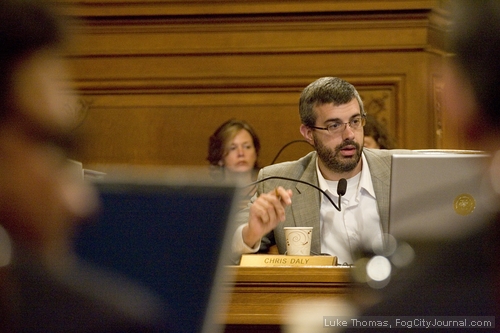
William Chadwick.
July 25, 2010
Last Tuesday’s Board of Supervisors meeting began with the now familiar pregnant two-second silence that follows the monthly question: “Is the Mayor in attendance?”
As has been customary for Mayor Gavin Newsom, he failed to attend the meeting, flouting the will of the electorate which passed a 2006 advisory measure requiring the mayor to be held accountable for his policies.
Ironic, then, that one of the debated articles on the Board’s agenda was Supervisor Chris Daly’s charter-amending ballot measure proposal, requiring, “the Mayor to appear personally at one regularly-scheduled meeting of the Board of Supervisors each month to engage in formal policy discussions with members of the Board.”

Supervisor Chris Daly.
Supervisor John Avalos weighed in, “I can’t think of a better time to see the Mayor. The mayor could explain to the people of San Francisco what is happening to their budget. I am in favor.”
Supervisor Ross Mirkarimi, who may have mayoral aspirations of his own, moved quickly to point out, to all those who might be afraid of holding Mayor Gavin Newsom to account, that this would have more of an effect on Newsom’s successor than the man himself. Nevertheless, right on cue, Supervisors Carmen Chu, Sean Elsbernd, Michela Alioto-Pier, Sophie Maxwell and Bevan Dufty dissented. Their opposition to executive accountability, however, was not enough to stop the measure from passing, 6 votes to 5.

Supervisors Ross Mirkarimi and John Avalos.
This was the closest-run vote of the meeting, but several other items were also closely contested both in vote and discussion, including Newsom’s ballot measure proposal to further indebt the electorate with a $46 million bond to pay for earthquake safety retrofitting of “multi-story wood framed affordable housing soft-story buildings.”
Following warnings that “we are due an earthquake on the Hayward fault any day now,” and impassioned speeches from some of the Emergency Response Center staff, the Mayor’s ballot measure proposal passed 6-4. Supervisors Chris Daly, Dufty, Elsbernd and Alioto-Pier dissented.
Another item that divided opinion on the Board was Daly’s proposed charter amendment requiring the Mayor’s Office of Housing to direct a third of future budget surpluses, for the next 15 years, towards an affordable housing fund. The measure would also require the “Office of Housing, in co-operation with the Department of Public Health and Department of Human Services, to prepare an affordable housing plan every three years and an annual affordable housing budget.”
Daly called it, “One of the toughest issues in San Francisco for a long time. There has been a lack of affordable housing for decades, and this will continue to be an issue for decades to come.” He argued that a 1996 $100 million housing bond had been the only successful attempt to deal with this issue, that several efforts have come up short over the years.
“It would be nice in 2010 if we had a long-term sustainable revenue stream for affordable housing,” Daly stated.
Supervisor Elsbernd, in opposition, argued the measure would “restrict future mayors,” and warned of “projected deficits,” pointing out that, if passed, it would require eight supervisors to countermand it.
“I caution you all to think about the future, and think about this measure being in the Charter,” Elsbernd said.

Supervisor Sean Elsbernd.
Deputy City Controller Monique Zmuda explained that, “in surplus years, the Mayor and Board of Supervisors have appropriated funds to pay for affordable housing. Once the baseline has been met, it cannot go below that baseline amount. It could go up or down based on the year.”

Deputy City Controller Monique Zmuda and Supervisor Daly.
This year, the baseline is $135.6 million, and it is the “first time in many, many years it has gone down. This year it did go down and it could go down,” said Zmuda. Finally, she argued the figures in question could, instead, be used to balance the budget. The subsequent vote saw the motion defeated 7-4, with Supervisors Maxwell, Mirkarimi, Avalos and Dufty joining the Newsom-appointee voting bloc of Chu, Elsbernd and Alioto-Pier.
The other item which engendered serious and lengthy debate was Supervisor Alioto-Pier’s attempts to push through “Laura’s Law,” calling for assisted outpatient treatment (AOT) as a cheaper and more effective alternative to jail sentences. Alioto-Pier claims that Laura’s Law, where implemented, has reduced incarceration by 87 percent.
“It works in New York,” Alioto-Pier stated. “It disrupts the revolving door system in place at the moment.”
“AOT is for the mentally disabled offenders, focusing on independence and allowing an individual to go out into the community – crisis management, housing, vocational training, drug rehab, medication,” Alioto-Pier added. “AOT is only currently available to those in the behavioral court system for those who break the law. AOT works well and efficiently, but it only works if you first break the law and are lucky enough to find yourself in front of the behavioral court system.”
AOT is currently being trialed in Novato and Los Angeles. Cost-efficiencies are being measured.
San Francisco General Department of Psychiatry Director Ira Katz, stated, “Medication is not possible for many of these patients. They often need care and treatment, depending on the particular needs of that patient. However, medication is the single most important part of this in most cases. Hopefully we can keep bad things from happening to otherwise good people.”
The bottom line: Implementing an AOT program via Laura’s Law will be less expensive than incarceration. It costs $100 thousand per year to keep someone in the prison system, and only $25 thousand to treat a patient in an AOT program.
Despite these seemingly overwhelming arguments, the motion was continued to August 3rd.
In conclusion, it seems like there are some shrewd and calculated voting patterns at these meetings that may have far reaching implications for whoever has pretensions to the throne of power. It also seems that not every vote by every supervisor is in the best interests of the City and its residents.

Supervisors Sean Elsbernd, Bevan Dufty and Carmen Chu shared a little levity with District 6 candidate for supervisor Debra Walker.

Board President David Chiu and Budget Committee Chair John Avalos discuss budget poker strategies.

Armed with leverage, Board President David Chiu, accompanied by his aide Judson True, enter Room 200 to play budget poker with Mayor Newsom. At stake, Newsom-opposed power sharing commission appointments versus budget add backs.


 The Hunger Site
The Hunger Site
August 2, 2010 at 11:34 am
Ann: I believe that these are where the statistics come from:
Business Insider: “50 Statistics About The U.S. Economy That Are Almost Too Crazy To Believe”
http://www.businessinsider.com/50-statistics-about-the-us-economy-that-are-almost-too-crazy-to-believe-2010-6#in-2010-the-us-government-is-projected-to-issue-almost-as-much-new-debt-as-the-rest-of-the-governments-of-the-world-combined-1
Specifically about banks owning a greater share of residential housing net worth:
The American Dream: “What Do You Own – Really?”
http://endoftheamericandream.com/archives/living-the-dream-what-do-you-own-really
July 30, 2010 at 1:51 pm
@Robert: Thanks for the stats. I was particularly intrigued by this one:
“• For the first time in U.S. history, banks own a greater share of residential housing net worth in the United States than all individual Americans put together.”
Do you have a citation on those stats, besides “statistics that a friend recently sent me”? I’m not doubting them; they’re believable, but I like to know where stats came from.
July 29, 2010 at 3:32 am
Robert,
You don’t sound nuts. My brother was schizophrenic for the last 40 years of his life and part of his condition was that he thought there was nothing wrong with him. But, when he was off his meds he ended up a thousand miles away walking barefoot in the snow having given away all of his possessions and the like. No one ever forced him to medicate but he accepted it for his last decades and we were all grateful.
That said, I think there’s something a bit more insidious about Pier’s proposal in SF. For year’s the Department of Public Health has been changing the mission of Laguna Honda from an old folks home to a facility to hold what they’re calling ‘psycho-socials’. Last I heard they have 300 beds in lock-downs ready and the sweep of the streets will soon begin. That’s when they’ll need Laura’s Law.
This one’s got me with mixed feelings. My right side says that no one should have to or be allowed to live ‘crazy’ on the streets. My left side says Tourette’s sufferers play great jazz music.
I dunno yet,
h.
July 28, 2010 at 9:23 am
Ralph’s arguments in favor of Laura’s Law is exactly the line touted ad nauseum by the establishment media.
The subtext is that the mentally ill poor and homeless do not really matter much as far as the bottom line goes– what matters most are our own selfish conveniences including a chance to shed our collective guilt and responsibility for properly providing for them.
Corporate interests remain unchanged: improving all revenue streams, and reducing opposition to its interests at all costs and on all fronts.
We are misdirected to believe that crime, prisons and policing are the only alternatives. They are not.
We are fed the suggestion that the ills of society are caused by the illness of individuals and not the illness of the society we live in.
A decent mental health system requires resources and planning not quick fixes, Laura’s Law being promoted as one. It requires a sound society and a caring community without illusions about the complexity of living.
How do we build a sound society?
Universal health would be helpful. Protecting people’s jobs and homes also. Building a benevolent safety net in the form of safe refuges for people who fall through the cracks (and the cracks are becoming chasms today) is yet another alternative to coercive psychology.
The real bottom line about Laura’s Law, in spite of the “tough love” its proponents profess, is an authoritarian assault on the last shreds of individual liberty, plain and simple.
It is a way to assert power and control– especially the power and control of the always implied threat: “You may be next.”
[“How’re ya doin’? How’re ya feelin’?” are questions always on the lips of those with the power to squeeze us– the same questions as the pathetic street dealers that embroider the corners for blocks around the Tenderloin Station.]
Who is to be deemed a danger to themselves or others?
The hysterical? The tweaking? The off-in-another-world person encrusted with dirt and scabies?
All good candidates.
How about the president and his legion of minions who can, with the help of a servile media, spin the recent release of tens of thousands of pages of documentation of war crimes, mayhem against civilians, and targeted assassinations, into arguments that allow the pouring of more billions into wars deemed supreme international crimes?
[Curious isn’t it that he and his minions when not rationalizing their crimes in terms of revenge against phantoms, frame their campaign of terror without end in the vilest platitudes of “tough love”.]
Should we deem the president, those he helps, and those who help him a danger to themselves, and others?
What would our decisions say about ourselves and our responsibilities, and the conveniences we enjoy by abdicating our own responsibilities?
For brutality? For fascism?
Compared to our foreign wars, the implementation of Laura’s Law seems to be mighty small potatoes. Unless we recognize it for what it is: a key to locking the door on the farthest refuge of dissent.
Had you not guessed by now, I am myself in the eyes of the American consensus thoroughly insane and unpredictable.
How about you?
July 27, 2010 at 6:44 pm
howard, in my own convoluted way that is what i was trying to say; there are many with whom i ‘agree’ that i would cross the street to avoid; there are also those i vehemently disagree (disagreed with – Harry Aleo) who i would cross the street to hug. Like h i just despise loudmouthed, chicken shits who lurk behind sheets and have the cojones of a gnat.
July 27, 2010 at 5:46 pm
I support Laura’s Law. Why? Because it has worked in New York where Kendra’s Law, the model for Laura’s Law, has been in effect since 1999. A 2005 study of Kendra’s Law found that 74 percent fewer experienced homelessness; 77 percent fewer experienced psychiatric hospitalization; 83 percent fewer experienced arrest; and 87 percent fewer experienced incarceration. As a component of the 2005 study, participants overwhelmingly endorsed the program: 75 percent reported that an assisted outpatient treatment (AOT) helped them gain control over their lives; 81 percent said that AOT helped them to get and stay well; and 90 percent said AOT made them more likely to keep appointments and take medication.
It is absurd to argue that the pharmaceutical industry endorses Laura’s Law because they will sell more drugs. How many drugs will pharma sell to San Francisco’s mentally ill homeless persons? Most mentally ill homeless persons have already been prescribed drugs. The problem is, they don’t take their drugs as prescribed. That’s why people with psychotic disorders who receive court-ordered treatment for 180 days will have significantly better outcomes than those who are given either intensive treatment alone, or a court order alone.
While we as a society must safeguard the civil rights of the unfortunate, we also have an obligation to care for those who are unable to care for themselves. Laura’s Law provides such safeguards.
Too often, we have a revolving door of homeless, especially the chronically mentally ill. They are picked up off the streets or in Golden Gate Park or at Homeless Connect. The homeless may or may not be placed in a treatment facility, if one is available. Once they complete treatment, they are too often dumped back on the streets with no housing, jobs, money, or followup by a professional case manager. In a short time, these homeless are back on the street. The Community Justice Center could invoke Laura’s Law for those who refuse medication because their illness impairs their ability to make rational decisions, and force them into outpatient treatment facilities and provide for a 180 day case managed followup.
I suggest that kneejerk opponents of Laura’s Law study Kendra’s Law.
July 27, 2010 at 11:51 am
Robert and Howard and others,
I like everyone on this site except for anonymous posters who attack. You can attack me and that’s fine, just use your real name. And Robert, that’s a great line on how people end up in SF. Someone once told me they were here because: “The country is slanted and all the loose marbles and nuts eventually slide into San Francisco.”. Sounds pretty reasonable. I tell people that I came here for two reasons. First, because where I came from I was considered radical and weird and here I’m considered boring. Second, where I came from when I walked into a room I usually became the smartest person there. In SF I become the dumbest. Great environment to learn from others. If you’re willing.
h.
July 27, 2010 at 11:12 am
P.S.: Interesting how we always jump to the “bottom line”. In the case of Laura’s Law that “The bottom line: Implementing an AOT program via Laura’s Law will be less expensive than incarceration.”
Why do we put money as the bottom line, and not the health of people as the real bottom line?
If money is to be our reigning standard, how about these statistics that a friend recently sent me:
• 83 percent of all U.S. stocks are in the hands of 1 percent of the people.
• 61 percent of Americans “always or usually” live paycheck to paycheck, which was up from 49 percent in 2008 and 43 percent in 2007.
• 66 percent of the income growth between 2001 and 2007 went to the top 1% of all Americans.
• 36 percent of Americans say that they don’t contribute anything to retirement savings.
• A staggering 43 percent of Americans have less than $10,000 saved up for retirement.
• 24 percent of American workers say that they have postponed their planned retirement age in the past year.
• Over 1.4 million Americans filed for personal bankruptcy in 2009, which represented a 32 percent increase over 2008.
• Only the top 5 percent of U.S. households have earned enough additional income to match the rise in housing costs since 1975.
• For the first time in U.S. history, banks own a greater share of residential housing net worth in the United States than all individual Americans put together.
• In 1950, the ratio of the average executive’s paycheck to the average worker’s paycheck was about 30 to 1. Since the year 2000, that ratio has exploded to between 300 to 500 to one.
• As of 2007, the bottom 80 percent of American households held about 7% of the liquid financial assets.
• The bottom 50 percent of income earners in the United States now collectively own less than 1 percent of the nation’s wealth.
• Average Wall Street bonuses for 2009 were up 17 percent when compared with 2008.
• In the United States, the average federal worker now earns 60% MORE than the average worker in the private sector.
• The top 1 percent of U.S. households own nearly twice as much of America’s corporate wealth as they did just 15 years ago.
• In America today, the average time needed to find a job has risen to a record 35.2 weeks.
• More than 40 percent of Americans who actually are employed are now working in service jobs, which are often very low paying.
• or the first time in U.S. history, more than 40 million Americans are on food stamps, and the U.S. Department of Agriculture projects that number will go up to 43 million Americans in 2011.
• This is what American workers now must compete against: in China a garment worker makes approximately 86 cents an hour and in Cambodia a garment worker makes approximately 22 cents an hour.
• Approximately 21 percent of all children in the United States are living below the poverty line in 2010 – the highest rate in 20 years.
• Despite the financial crisis, the number of millionaires in the United States rose a whopping 16 percent to 7.8 million in 2009.
• The top 10 percent of Americans now earn around 50 percent of our national income.
Sometimes I think I need to smoke a joint.
July 27, 2010 at 10:44 am
brookse32’s comment underscores the real danger of Laura’s Law and I applaud Ira Katz for pulling some breaks, the Board putting off a knee jerk decision to implement the law, Chadwick for reporting it, and Luke for posting it.
Will the establishment media ever investigate the Big Pharma connection to NAMI and its chapters?
Not a day goes by without my hearing or reading about some new illness that can be readily treated… the other day a form of postpartum depression in men, or another day, “early on-set” Alzheimers.
I believe in the simple rule that if you do not hurt yourself and do not hurt others you should be free to be who you want to be, think what you want to think, go where you want to go, say what you want to say. (Of course life throws many curve balls, we don’t always know how we affect ourselves or others; good logic helps. Too many people play it safe without ever bothering to just think– and many people get hurt.)
Someone said once that if you are not free you come to America. If you are not free in America, you come to San Francisco.
The truth is that no place is truly free except a place in one’s own mind. Without belittling the storms, quirks, and rainbows that indelibly mark us all as individuals, and our shared need to become more human through knowledge and love, the mind should be sacrosanct. Respect for the mind is not trivial, or as yet, immunizable or beyond deep controversy.
Those who profess otherwise are living in a dark age as yet to be revealed.
July 27, 2010 at 10:30 am
h, Patrick, John A. and everyone else:
Remember that disagreement is not a synonym for dislike.
July 26, 2010 at 7:02 pm
Nice shots — pretty much capture my mood of being held hostage on the budget. Can’t say much about the analysis though.
July 26, 2010 at 6:22 pm
h
Thats just one of the negatives we have to live with as we struggle to preserve what little remains of ‘democracy’, the right to Free Speech and the right to Vote. It confers the same rights even on those too afraid and base to identify themselves and put their mug where their mouth is; from generic hooded Klansmen and terrorists to anonymous arseholes. Much though we may disagree with Rob A; Ruth R; Howard E; etc. They have the courage of their convictions and I respect them for that.
As for these other dipshits, well, I think one of my countrymen, another dead old white guy, made a pretty astute observation in days of yore …
“……………. a poor player
That struts and frets his hour upon the stage
And then is heard no more: it is a tale
Told by an idiot, full of sound and fury,
Signifying nothing.”
Jeez, did I just write my own epitaph.
PS
See ya Sunday. Dont know which ‘thunder thighs’ you are referring to, but I’m sure there will be far more than you can handle, fondle, or remember and respect in the morning.
July 26, 2010 at 4:33 pm
Understatement of the commentary – “It also seems that not every vote by every supervisor is in the best interests of the City and its residents.”
July 26, 2010 at 12:01 pm
Laura’s Law Is Big Pharma Manipulation To Force Millions Onto Meds
It is crucial to understand that NAMI, the main organization pushing both Laura’s Law, and Alioto-Pier’s local resolution, gets a vast majority of its funding from the pharmaceutical industry. To see details on this connection with the drug industry go to http://www.ahrp.org/cms/content/view/587/55/ and http://www.mindfreedom.org/kb/psych-drug-corp/nami
NAMI, the National Alliance on Mental Illness (locally SF NAMI), has spent decades pushing aggressive and epidemic over-diagnosis of mental illness, in order to trick, and even force, millions of innocent healthy people (a vast number of them children) onto extremely dangerous psychoactive drugs, most with heavy side effects that neuter the lives of the people who are naively taking them; and often lead to profound mental illness that never would have occurred, suicide, aggressive behavior, and even deadly violence.
NAMI accomplishes this by convincing the public, patients, well meaning advocates, and mental health professionals, that normal human behaviors, such as shyness or lack of attention in school, are illnesses caused by ‘chemical imbalances’ in the brain, which need to be treated with medication. This ‘chemical imbalance’ theory though it has been widely accepted as fact because of huge PR campaigns from groups like NAMI, has absolutely no basis in proven science whatsoever.
One of the most egregious accomplishments of NAMI is the pushing of false pseudo-diagnoses of ‘ADD’ and ‘ADHD’ so effectively that it has succeeded in forcing millions of innocent healthy school children onto the drug Ritalin, ruining their childhoods and devastating their adult lives.
It is easy to be swayed by local NAMI organizers, because they are often very well meaning volunteers, who really care about legitimate mental illness, and who often work on expanding non-drug treatments; but they have also been deeply manipulated and duped by NAMI PR and literature into pushing hard for massive over-prescription of psychoactive drugs.
As the primary supporter of legislation like “Laura’s Law” NAMI has one agenda, and that is to force millions -more- people nationwide, onto profitable, but unnecessary, and life threatening drugs.
And it is particularly disturbing that representatives of NAMI have gained seats and heavy influence on our own local Mental Health Board. This connection with NAMI on our local board should be investigated immediately, and in light of the pharmaceutical industry manipulation of NAMI, all Mental Health Board members who are paid by NAMI, or receive funding/support from NAMI for their local work or nonprofits, should be removed due to clear conflict of interest.
Eric Brooks
July 26, 2010 at 8:36 am
Luke,
Why don’t you require ‘generic’ to ID themselves? They use the cover of anonymity to attack from behind your skirts and that just isn’t right.
h.
July 26, 2010 at 8:34 am
Chadwick failed to mention that city voters already rejected the mandatory question time idea in 2007. Is this issue going to be like public power and put before the voters and rejected year after year?
July 25, 2010 at 4:18 pm
You know that part where it reads, “flouting the will of the electorate” and then reads, “advisory measure” right afterword?
When we don’t take advice, we FLOUT it, baby.